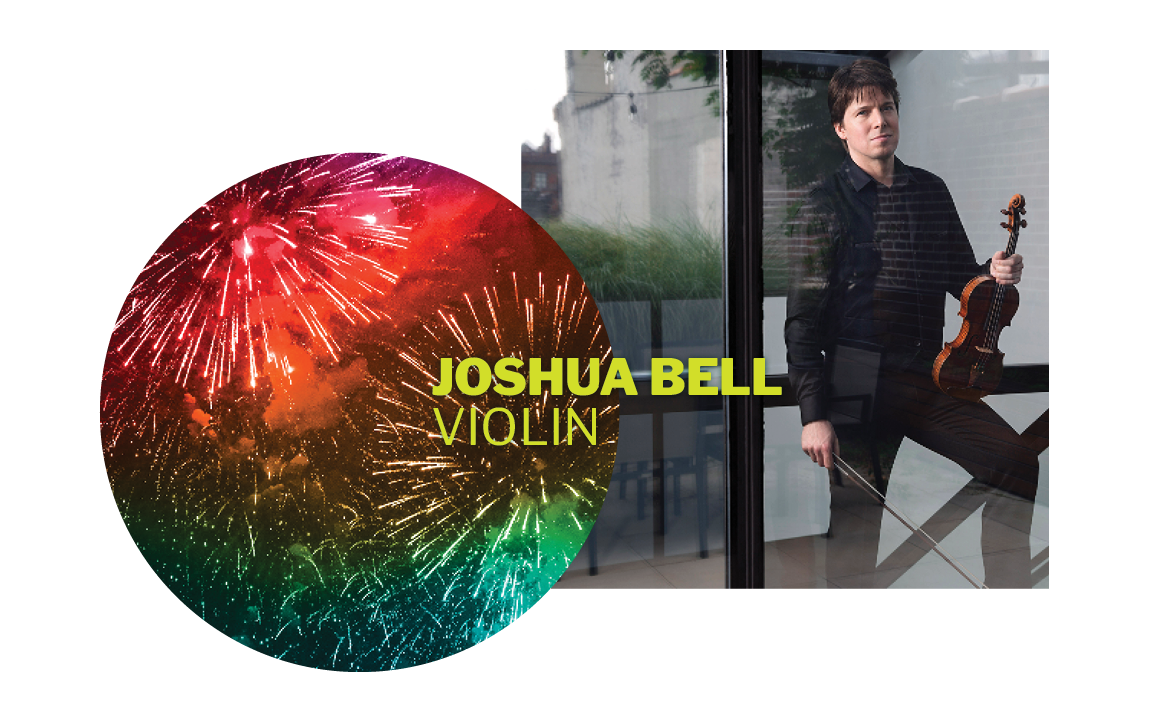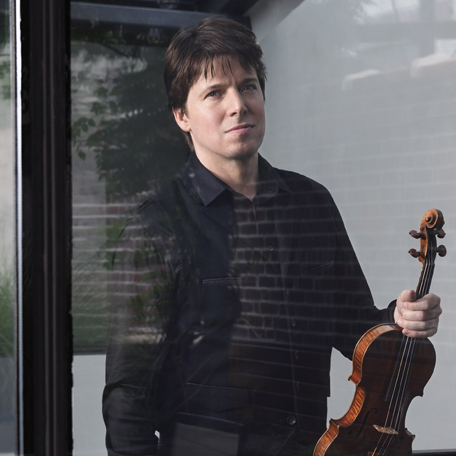FIREWORKS WITH JOSHUA BELL
Saturday, April 1 at 7:30pm
Sunday, April 2 at 3:00pm

FIREWORKS WITH JOSHUA BELL
Saturday, April 1 at 7:30pm
Sunday, April 2 at 3:00pm

FIREWORKS WITH JOSHUA BELL
Saturday, April 1 at 7:30pm
Sunday, April 2 at 3:00pm

Location
The Palace Theatre
61 Atlantic Street, Stamford, CT 06901
Duration
2 hours with a 20
minute intermission
Share With
About this performance
Written at just 25 years of age, Brahms’ Serenade is a young person’s piece, full of life, energy and spirit. A quixotic flash of Baroque light comes from the vibrant American composer Stacey Garrop, inspired by Handel’s famous Royal Fireworks Music. A fireworks show is what audiences have come to expect when Joshua Bell takes the stage, a rare artist who can transcend instrumental technique and communicate directly with his audiences. The Mendelssohn violin concerto is ardently melodic and rhythmically exuberant, and there is no better way to experience it than through the eloquent artistry of Joshua Bell.
Michael Stern, conductor
Joshua Bell, violin
Behind the Baton
Learn more about the program during this pre-concert talk hosted by Music Director Michael Stern. Behind the Baton begins one hour before each concert at the Palace Theater.
MusiKids
A 40-minute, interactive pre-concert activity for families led by an Orchestra musician. MusiKids begins one hour before our Sunday concerts at The Palace Theatre.
This event is FREE with your ticket to the concert.
Sunday tickets for kids (ages 17 and under) are only $4 with the purchase of a regular ticket.
Musical Program to include
Stacey Garrop Spectacle of Light
Felix Mendelssohn Violin Concerto
Johannes Brahms Serenade No. 1
Featured Artists
Joshua Bell violin

With a career spanning almost four decades, GRAMMY® Award-winning violinist Joshua Bell is one of the most celebrated artists of his era. Having performed with virtually every major orchestra in the world, Bell continues to maintain engagements as soloist, recitalist, chamber musician, conductor and Music Director of the Academy of St Martin in the Fields.
Bell’s highlights in the 2021-22 season include leading the Academy of St Martin in the Fields at the 2021 BBC Proms, throughout Europe, and the U.S. on tour; returning with the Philadelphia Orchestra for a play/conduct program, to the Verbier Festival, the Minnesota Orchestra, and the New York Philharmonic; and tours with the Israel Philharmonic and NDR Elbphilharmonie Orchestra as soloist. Additional 2021-22 performances to be announced.
During the COVID-19 pandemic, Bell joined the classical music world in bringing world-class performances online. In summer 2020, PBS presented Joshua Bell: At Home With Music, a nationwide broadcast directed by Tony and Emmy award winner, Dori Berinstein, produced entirely in lockdown. The program included core classical repertoire as well as new arrangements of beloved works, including a West Side Story medley. The special featured guest artists Larisa Martínez, Jeremy Denk, Peter Dugan, and Kamal Khan. In August 2020, Sony Classical released the companion album to the special, “Joshua Bell: At Home With Music.”
In 2011, Bell was named Music Director of the Academy of St Martin in the Fields, succeeding Sir Neville Marriner, who formed the orchestra in 1959. Bell’s history with the Academy dates back to 1986 when he first recorded the Bruch and Mendelsohn concertos with Mariner and the orchestra. Bell has since directed the orchestra on several albums including Vivaldi’s Four Seasons, Voice of the Violin, For the Love of Brahms, and most recently, Bruch: Scottish Fantasy, which was nominated for a 2019 GRAMMY® Award.
Bell has been active in commissioning new works from living composers and has premiered concertos of John Corigliano, (double concerto) Edgar Meyer, Behzad Ranjbaran and the Nicholas Maw’s Violin Concerto, for which his recording received a GRAMMY® award.
Bell has also collaborated with artists across a multitude of genres. He has partnered with peers including Renée Fleming, Chick Corea, Regina Spektor, Wynton Marsalis, Chris Botti, Anoushka Shankar, Frankie Moreno, Josh Groban, and Sting, among others. In Spring 2019, Bell joined his longtime friends and musical partners, cellist Steven Isserlis and pianist Jeremy Denk, for a ten-city American trio tour; the trio recorded Mendelssohn’s piano trios at Capitol Studios in Hollywood, slated for release next season. Following Bell’s second collaboration with the Singapore Chinese Orchestra and Maestro Tsung Yeh in 2018, an upcoming album release features Bell as soloist alongside traditional Chinese instruments performing Western repertoire and the Butterfly Lovers’ Violin Concerto, one of the most renowned violin works in Chinese cultural heritage.
In 1998 Bell partnered with composer John Corigliano and recorded the soundtrack for the film the Red Violin, which helped Joshua Bell become a household name and garnered an Academy award for the composer. Since then, he has appeared on several other film contracts including Ladies in Lavender (2004) to Defiance (2008).
Bell has also appeared three times as a guest star on The Tonight Show with Johnny Carson and made numerous appearances on the Amazon series Mozart in the Jungle. Bell is featured on six Live From Lincoln Center specials, as well as a PBS Great Performances episode, “Joshua Bell: West Side Story in Central Park.” In 2018-19, Bell commemorated the 20th anniversary of The Red Violin (1998), bringing the film with live orchestra to various festivals and the New York Philharmonic.
Bell’s interest in technology led him to partner with Embertone, the leading virtual instrument sampling company, on the Joshua Bell Virtual Violin, a sampler created for producers, engineers, artists, and composers. Bell also collaborated with Sony on the Joshua Bell VR experience. Featuring Bell performing with pianist Sam Haywood in full 360-degrees VR, the software is available on Sony PlayStation 4 VR.
As an exclusive Sony Classical artist, Bell has recorded more than 40 albums garnering GRAMMY®, Mercury®, Gramophone and OPUS KLASSIK awards. Bell’s Fall 2019 Amazon Music Originals new Chopin Nocturne arrangement was the first classical release of its kind on the platform. Bell’s 2016 release, For the Love of Brahms, includes 19th-century repertoire with the Academy, Steven Isserlis, and Jeremy Denk. Bell’s 2013 album with the Academy of St Martin in the Fields, featuring Bell directing Beethoven’s Fourth and Seventh symphonies, debuted at No. 1 on the Billboard charts.
In 2007, a Pulitzer Prize-winning Washington Post story, centered on Bell performing incognito in a Washington, D.C. metro station, sparked an ongoing conversation regarding artistic reception and context. The feature inspired Kathy Stinson’s 2013 children’s book, The Man With The Violin, and a newly-commissioned animated film, with music by Academy Award-winning composer Anne Dudley. Stinson’s subsequent 2017 book, Dance With The Violin, illustrated by Dušan Petričić, offers a glimpse into one of Bell’s competition experiences at age 12. Bell debuted The Man With The Violin festival at the Kennedy Center in 2017, and, in March 2019, presented a Man With The Violin family concert with the Seattle Symphony.
In August 2021, Bell announced his new partnership with Trala, the tech powered violin learning app, which Bell will work with to develop a unique music education curriculum. Bell maintains active involvement with Education Through Music and Turnaround Arts, which provide instruments and arts education to children who may not otherwise experience classical music firsthand. In 2014, Bell mentored and performed alongside National YoungArts Foundation string musicians in an HBO Family Documentary special, “Joshua Bell: A YoungArts Masterclass.” Bell received the 2019 Glashütte Original MusicFestivalAward, presented in conjunction with the Dresden Music Festival, for his commitment to arts education.
Born in Bloomington, Indiana, Bell began the violin at age four, and at age twelve, began studies with his mentor, Josef Gingold. At age 14, Bell debuted with Riccardo Muti and the Philadelphia Orchestra, and made his Carnegie Hall debut at age 17 with the St. Louis Symphony. At age 18, Bell signed with his first label, London Decca, and received the Avery Fisher Career Grant. In the years following, Bell has been named 2010 “Instrumentalist of the Year” by Musical America, a 2007 “Young Global Leader” by the World Economic Forum, nominated for six GRAMMY® awards, and received the 2007 Avery Fisher Prize. He has also received the 2003 Indiana Governor’s Arts Award and a Distinguished Alumni Service Award in 1991 from the Jacobs School of Music. In 2000, he was named an “Indiana Living Legend.”
Bell has performed for three American presidents and the sitting justices of the Supreme Court of the United States. He participated in former president Barack Obama’s Committee on the Arts and Humanities’ first cultural mission to Cuba, joining Cuban and American musicians on a 2017 Live from Lincoln Center Emmy nominated PBS special, Joshua Bell: Seasons of Cuba, celebrating renewed cultural diplomacy between Cuba and the United States.
Bell performs on the 1713 Huberman Stradivarius violin.
Program Notes
Spectacle of Light
Stacy Garrop
b.1969
Stacy Garrop composed Spectacle of Light in 2020, commissioned by the Music of the Baroque Orchestra. The inspiration came from a 1749 etching of the fireworks on the River Thames, celebrating King George II’s signing of the treaty at Aix-la-Chapelle (Aachen in Germany) that officially ended the War of Austrian Succession. A grand spectacle of fireworks and music was a typical way at the time to celebrate significant events. It is the same event for which George Frideric Handel wrote Music for the Royal Fireworks.
Observing how fireworks rise, bloom, and overlap with each other to create a rich, complex, and fleeting tapestry of color, Garrop realized that fireworks and music share an ephemeral nature in that they both delight our senses before fading into memory.
“Ultimately, I decided that Spectacle of Light would represent the experience of a fireworks show. The music starts with great anticipation as the crowd waits in darkness, then a single firework illuminates the sky, followed by a massive eruption of light, color, and sound. After this initial frenzied burst, the fireworks quiet down into a slower-paced, mesmerizing display of colors.” The work ends with an unresolved note into silence, as if expecting the next movement to burst forth. Fittingly, a number of hints from Handel’s Fireworks are hidden in the music.
An Assistant Professor in Composition at the Chicago College of the Performing Arts at Roosevelt University, Garrop has a D.M. from Indiana University. Her numerous works have been widely performed by ensembles here and overseas.
Violin Concerto in E minor, Op. 64
Felix Mendelssohn
1809-1847
As a mature artist, Felix Mendelssohn was acclaimed throughout Europe as a composer and conductor, especially in his native Germany and in England, where he had a private audience with the young Queen Victoria, who sang for him after he had played for her. His untimely death from unknown causes created a profound shock, and Mendelssohn societies promoting his music and ideas quickly sprang up all over middle and northern Europe.
Fortunately for the development of Mendelssohn’s prodigious talents, his carefully selected teachers were strict and demanding. Even as a mature artist, he was extremely self-critical, constantly requesting feedback and carefully perfecting his compositions. The Concerto in E minor had a long gestation period. Mendelssohn started the concerto in 1838 but did not finish it until six years later. He wrote it for his friend, the famed violinist Ferdinand David (1810-1873), concertmaster of the Gewandhaus Orchestra of Leipzig where Mendelssohn served as conductor from 1835 to 1843. The composer sought – and took – David’s advice on technical aspects throughout its composition. David finally premiered it in Leipzig in 1845, but Mendelssohn was ill and unable to attend. Now one of the staples of violin repertory, contemporaneous audiences considered the Concerto daring and innovative
From the first bar, the Allegro molto appassionato broke new ground. Instead of the usual orchestral exposition of the main themes, the violin enters at once with the principal theme on which the movement is built. For the second theme, the roles are reversed, with the winds introducing the theme. The cadenza, largely David’s creation, is placed unconventionally before the recapitulation. Relocating the cadenza away from its traditional place at the end of the movement stresses continuity with the second movement, which follows without pause.
The Andante emerges out of a single quiet bassoon tone, emanating from the last chord of the opening movement. It is joined by other instruments for a short transitional passage, after which the solo violin introduces the simple, almost religious theme.
Another transition, based on the opening theme of the Concerto, leads into the Allegro molto vivace. Mendelssohn saved the demonstration of the violin’s virtuoso possibilities for this sparkling Finale. After an orchestral fanfare for the winds, the soloist enters with a flourish followed by a delicate, dancing theme that dominates the movement and recalls the atmosphere of the teenaged composer’s first great hit, the Overture to A Midsummer Night’s Dream.
Serenade No. 1 in D major, Op. 11
Johannes Brahms
1833-1897
The eighteenth century witnessed the birth of many of the important genres in classical music: the symphony, the string quartet and the piano trio were among the important new musical genres. The instrumental serenade was another, written in a light vein designed primarily for entertainment and, frankly, background music for social gatherings and meals. It developed as a hybrid of chamber and orchestral music, as well as the dance suite, with three to ten relatively short movements, often involving unusual instrumental combinations, as in Mozart’s Serenade for 13 Wind Instruments. In the hierarchy of musical genres of the time, the serenade was definitely second class – although not necessarily in musical quality, as witnessed by the aforementioned Mozart serenade.
As a classically oriented composer who revered Beethoven, writing a symphony was a daunting proposition for Johannes Brahms. “You don’t know what it is like always to hear that giant marching along behind me,” he wrote. By the late 1850s, after nearly four years under the benevolent influence of Clara and Robert Schumann, Brahms was ready to strike out to find his own symphonic voice. The two youthful serenades and the Piano Concerto No.1 in D minor composed in his mid-20s had been a way to evade Beethoven’s ghost while allowing him to gain experience in orchestration. The orchestration of an initial attempt at a symphony in 1854 had caused such difficulty for the inexperienced composer that he dropped the project. While in the end Brahms composed four symphonies, the first did not premiere until 1876.
Brahms completed the Serenade in D major in the summer of 1857, originally as a nonet for winds and strings. Dissatisfied with the scoring, Brahms re-scored it immediately for small orchestra and then again in 1859 for fuller orchestra in the form we know it today. Its original instrumentation, however, is reflected in the fact that there are no trombones or tuba. Its gentle and modest mood stands in stark contrast to his first performed work for full orchestra, the gargantuan and passionate First Piano Concerto. The Serenade, by contrast, is a joyous work, whose style harks back to the symphonies and serenades of Haydn and the early symphonies of Beethoven. Its six movements and great length render it a substantial achievement, not to mention the originality of the manner in which Brahms handles the traditional movement structures – sonata form, scherzo/trio, rondo, etc. – a symphony by any other name…
The opening movement, although in sonata form, has about it a playful quality. The first theme is a horn solo, followed by an answer from a solo clarinet, oboe and then the violins – almost as if the individual instruments were calling to their companions to join a game for full orchestra. The close is perhaps the main quality that distinguishes it from a true symphonic first movement; instead of the expected fortissimo orchestral cadence, Brahms ends with a whisper of woodwind solos as if playtime is over and the individual instruments disperse for the day.
The Scherzo represents a wonderful example of how Brahms could push the structural envelope for this descendant of the classical minuet and trio. While the model contains clear-cut foursquare phrases and repeats, Brahms disguises the traditional guideposts by irregular and extruded phrase length and the blurring of the structural boundaries of the repeats. The Trio, by contrast, is more traditional in its clear-cur repeats.
The third movement, marked Adagio non troppo, is a treasure trove of melodies in a much-expanded classic form for slow movements, ABA, with three principal themes in the A section. Brahms spins out all three themes, incorporating variations of the basic musical ideas and adding new melodic content.
Considering the heft of the first three movements, it is something of a surprise to hear what Brahms does with the fourth and fifth; structurally and melodically they are as transparent as the first three are sophisticated. Although Brahms titles his fourth movement Minuet 1 and 2, taken together they are identical to the classic minuet/trio structure.
The Scherzo that follows harks back to Beethoven, who invented the form, fashioning it out of the old minuet by speeding it up and divorcing it once and for all from the dance. Both scherzo and trio sections feature the horns in a stereotypical hunting motive, reemphasizing their importance as signaled by the opening of the entire work.
The Finale is a rondo, whose melody is stomped out on the double basses and bassoons. The first episode introduces a contrasting theme, which recurs in various guises throughout the movement.
Program notes by:
Joseph & Elizabeth Kahn
Wordpros@mindspring.com
www.wordprosmusic.com
*artists and programs subject to change







